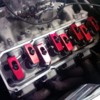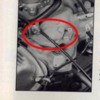Don't know how to edit my own posts here: during the period ZF made 'ZF-Ross", 'ZF-Gemmer' worm & roller, and ZF ball-and-nut (power) steering boxes. Which one is used in Longchamps or Deauvilles?
quote:Originally posted by Bosswrench:
Don't know how to edit my own posts here: during the period ZF made 'ZF-Ross", 'ZF-Gemmer' worm & roller, and ZF ball-and-nut (power) steering boxes. Which one is used in Longchamps or Deauvilles?
I'm told all series 3 have them, but I don't know exactly which of the above...
Nice job Mikael 
quote:Originally posted by No Quarter:
Doug, do you know the ratio in my Longchamp?
No. I know little about the car itself. Consider though that the Pantera is 4.22:1 with a 2.20:1 first gear. When you multiply those numbers it comes remarkably close to what a Mustang with a 3.89:1 rear and a 2.32 first gear has.
I can tell you from experience though that if you want the Mustang to pull hard enough to break a 15.0 second 1/4 mile you really need 4.33 rear end ratio with that transmission.
Automatics complicate that formula though. Generally they have a lower ratio first gear and the torque converter because it slips some, adds more rpm to the engine at that point. As if the car had lower gears.
If I remember correctly, a C6 with a 3.50 rear is approximately equal to the 3.89/2.32 manual ratio?
Some people have been successful with using the 78 or so Granada transmission in the car since it has an overdrive top gear. This gives you the bottom end that you need and recovers some of the lost gas mileage at the top because of the increase rpm.
Any way you look at it though, looks like if you got around 12 mph, that's going to be about the best you can do with that car and engine setup.
It wasn't built at a time when high mileage was a major concern.
It gets 16 mpg on my commute to work
Got so far on the Longchamp I could try closing the hood with the new spacer on, there was enough room, phew
Pushrods received so I could assemble it all. Picture from just before soaking in oil. It's a shame that the valvetrain isn't visible with the engine running I think.
I got it started, idle is fine, vacuum rock steady, no ticking sounds. That's all for right now, weather and salty roads will delay test drive
I got it started, idle is fine, vacuum rock steady, no ticking sounds. That's all for right now, weather and salty roads will delay test drive
Attachments
Nice - looking forward to seing it back out there
quote:Originally posted by No Quarter:
It's a shame that the valvetrain isn't visible with the engine running I think.
That can be arranged.
Good work Mikael. Following with great interest.
quote:Originally posted by No Quarter:
It's a shame that the valvetrain isn't visible with the engine running I think.
I remember SOMEONE making clear Lexan valve covers maybe 25 years ago. I haven't seen them since.
It might have been small block Chevy only. Maybe?
I think they were made for racing purposes? Drag racing primarily. This way you could visually check for issues on a running engine without tearing it down.
Wow, that's a memory test for sure. Who the heck made these things?
I want to say it was one of the large camshaft companies. Check ebay. Maybe a lead will turn up there?
That companies website came up with a google search. Expensive $285 and Chevy only. http://www.clearvueconcepts.com/products.htm
don't think it keeps clean very long...just one good reving ?
and.. it would make me scared, just seeing all those moving parts...and hope they keep moving
and.. it would make me scared, just seeing all those moving parts...and hope they keep moving
The bracket I was needing, I welded something instead...
Back to the +100HP(?). Last weekend it was time to drive it, to test it, was it a rocketship now? Not really. So far it's been disappointing.
The first trip I couldn't feel much difference, only that it spun its wheels more often, a good sign, damp roads. But when I got home I knew what to do, having read my own book (sorry). Ignition had just been set as per ICE's recommendations, 16 degrees initial and I set the ignition box to +12@3800. It definitely felt like too little too late, both by being slow and by backfiring a little bit. I tried to do +12@2800 (there are 16 different settings in the ICE-box), that helped, so I was right about needing to get earlier ignition. I would have to forget about the ICE recommendation and do the tuning as in my book. So I drove home, to get my pen and paper and timing light and 1/2" wrench. But parked outside and hot, it wouldn't start. Hhmm. You can't tune your car if the basic like starting and not overheating are not OK. So had to fix that first.
I'll spare you the details on fixing the hot start problem, but it involved dismantling starter and routing new wiring. Now the starter runs faster than ever. But rain had started, so no more tuning that weekend. To be continued...
One more thing that made the Longchamp feel slower than it should be was that I had no kick down anymore. Just raising the carb 5/8" eliminated the kick down, so I had to bend the rod in a few places.
So now it's ready to go tuning. Just need the time and weather to do it...
The first trip I couldn't feel much difference, only that it spun its wheels more often, a good sign, damp roads. But when I got home I knew what to do, having read my own book (sorry). Ignition had just been set as per ICE's recommendations, 16 degrees initial and I set the ignition box to +12@3800. It definitely felt like too little too late, both by being slow and by backfiring a little bit. I tried to do +12@2800 (there are 16 different settings in the ICE-box), that helped, so I was right about needing to get earlier ignition. I would have to forget about the ICE recommendation and do the tuning as in my book. So I drove home, to get my pen and paper and timing light and 1/2" wrench. But parked outside and hot, it wouldn't start. Hhmm. You can't tune your car if the basic like starting and not overheating are not OK. So had to fix that first.
I'll spare you the details on fixing the hot start problem, but it involved dismantling starter and routing new wiring. Now the starter runs faster than ever. But rain had started, so no more tuning that weekend. To be continued...
One more thing that made the Longchamp feel slower than it should be was that I had no kick down anymore. Just raising the carb 5/8" eliminated the kick down, so I had to bend the rod in a few places.
So now it's ready to go tuning. Just need the time and weather to do it...
As I'm writing this I see snow coming down... 
It isn't going to pull at all without changing the gearing. You could put a 500hp supercharger on the car and it would still be sluggish without the gears.
Adding 100hp to this setup won't even show in 1/4 mile times.
How much does the car weigh?
what I'm thinking is that you really need 4.33:1 rear gears with an overdrive transmission so you can cruise reasonably with it.
I'd take a guess and say you probably have something around a 3.00:1 rear ratio now? With that it is a 16 or 17 second 1/4 mile car and won't embarrass a Ferrari unless it is Uncle Luigi Ferrari (no relationship) and he is pushing a gellato cart?
Adding 100hp to this setup won't even show in 1/4 mile times.
How much does the car weigh?
what I'm thinking is that you really need 4.33:1 rear gears with an overdrive transmission so you can cruise reasonably with it.
I'd take a guess and say you probably have something around a 3.00:1 rear ratio now? With that it is a 16 or 17 second 1/4 mile car and won't embarrass a Ferrari unless it is Uncle Luigi Ferrari (no relationship) and he is pushing a gellato cart?
Today I could test a bit more on the Longchamp. I decided to ignore all the good advice and manufacturer’s recommendation and follow the process in my book. I set the initial timing by the vacuum gauge, ended up with 8 degrees earlier timing as the best steady high vacuum. I listened for detonation, couldn’t hear any, and tested if it could start with that early timing, it could. My timing gun showed 24 degrees at idle with vacuum disconnected and plugged. That’s a lot, right? Well maybe my balancer doesn’t show TDC correctly or my timing gun is faulty. Who knows? All I know is that my engine liked 24 degrees better than 16 degrees as read on the balancer. So who cares about the numbers? I don’t. And that just goes to prove the main point in my book, you can NOT set your timing based on your Haynes manual or the manufacturer’s recommendation or your best friend’s recommendation or the fastest guy in town’s recommendation. Only the vacuum gauge and the trial and error method I describe in my book will optimize your engine! Now, you can consider this posting a blatant attempt to sell books, or you can go for those free +25-50HP a perfectly tuned engine will give you. Up to you... 
The test drive felt like another car. It now easily spins its wheel, in fact on the semi damp roads this morning it was impossible to measure a 0-60, it just spun its wheels all the time. Those that have read my book knows that you can’t tune any further unless you have consistent dry roads to do it on, so fine tuning and playing with the 16 curves in the ICE box will have to wait a few weeks. I don’t expect to find a lot of extra power still, but you never know.

If you copy my way of tuning, remember to always err on the side of caution, meaning start with too late timing and go earlier and earlier until you get best performance and no detonation.
The test drive felt like another car. It now easily spins its wheel, in fact on the semi damp roads this morning it was impossible to measure a 0-60, it just spun its wheels all the time. Those that have read my book knows that you can’t tune any further unless you have consistent dry roads to do it on, so fine tuning and playing with the 16 curves in the ICE box will have to wait a few weeks. I don’t expect to find a lot of extra power still, but you never know.
If you copy my way of tuning, remember to always err on the side of caution, meaning start with too late timing and go earlier and earlier until you get best performance and no detonation.
Mikael just out of curiosity how much does it advance to/max when you rev it?
Jan
Jan
Haven't checked... And if the idle number maybe is wrong, then the max will also be. The curves in the box will add from 6 to 20 degrees, I'll play with them later
Add Reply
Sign In To Reply



